Synthesis and in vitro and in vivo evaluation of urea-based PSMA inhibitors with increased lipophilicity
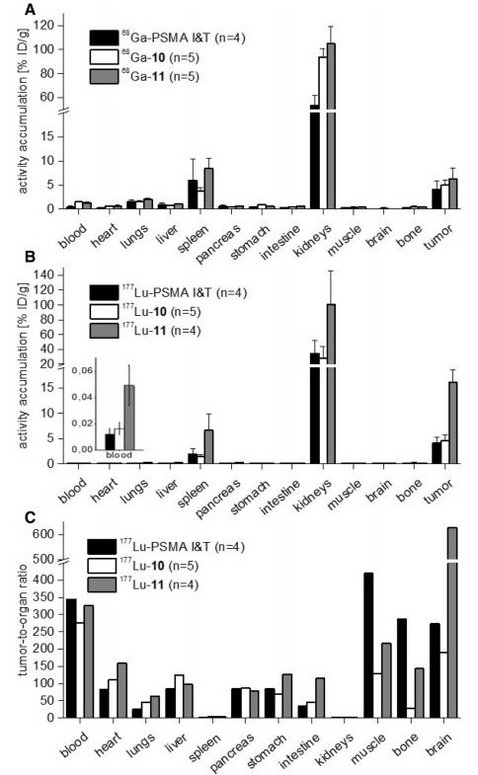
22.08.2018
Several radiolabeled prostate-specific membrane antigen (PSMA) inhibitors based on the lysine-urea-glutamate (KuE) motif as the pharmacophore proved to be suitable tools for PET/SPECT imaging of the PSMA expression in prostate cancer patients. PSMA I&T, a theranostic tracer developed in our group, was optimized through alteration of the peptidic structure in order to increase the affinity to PSMA…
Imaging Characteristics and First Experience of [68Ga]THP-PSMA, a Novel Probe for Rapid Kit-Based Ga-68 Labeling and PET Imaging: Comparative Analysis with [68Ga]PSMA I&T
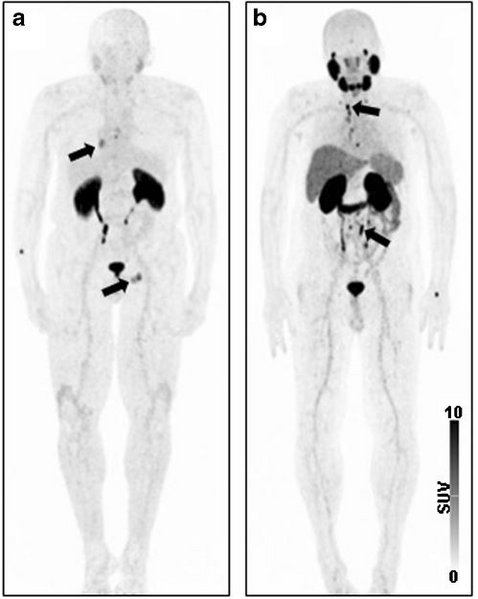
01.08.2018
PURPOSE: [68Ga]Trishydroxypyridinone (THP)-prostate-specific membrane antigen (PSMA) is a novel tracer that can be labeled in one step by cold reconstitution of a kit with unprocessed generator eluate, targeting PSMA via the lysine-urea-glutamate (KuE) motif. The aim of this study was to evaluate the human imaging characteristics of [68Ga]THP-PSMA. PROCEDURES: [68Ga]THP-PSMA positron emission tomography (PET)/x-ray computed tomography (CT) was performed in 25 patients with biochemical recurrence after radical prostatectomy for prostate cancer. Urinary and biliary excretion and tumor lesion uptake were quantified…
Molar Activity of Ga-68 Labeled PSMA Inhibitor Conjugates Determines PET Imaging Results
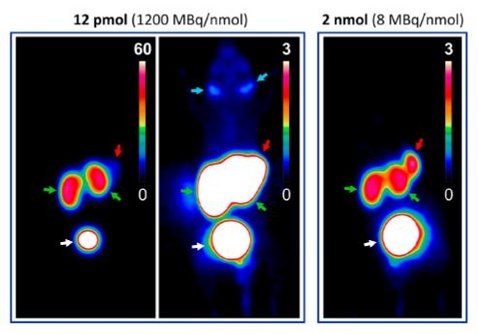
27.07.2018
Radiopharmaceuticals targeting the enzyme prostate-specific membrane antigen (PSMA; synonyms: glutamate carboxypeptidase II, NAALADase; EC 3.4.17.21) have recently emerged as powerful agents for diagnosis and therapy (theranostics) of prostate carcinoma (PCa). The radiation doses for therapeutic application of such compounds are limited by substantial uptakes in kidneys and salivary glands, with excess doses reportedly leading to radiotoxicity-related adverse effects, such as kidney insufficiency or xenostomia. On the basis…
Effect of Carbohydration on the Theranostic Tracer PSMA I&T
25.07.2018
To investigate the effect of carbohydrate moieties on the pharmacokinetic profile of prostate-specific membrane antigen (PSMA) inhibitors, carbohydrated derivatives of the established PSMA-targeted radiopharmaceutical PSMA I&T were developed and evaluated. As observed for the reference PSMA I&T, the natGa/natLu complexes…
Targeting Chemokine Receptor CXCR4 and Translocator Protein for Characterization of High-Risk Plaque in Carotid Stenosis Ex Vivo
12.07.2018
BACKGROUND AND PURPOSE: This pilot study aims to demonstrate the feasibility of targeting molecular characteristics of high-risk atherosclerotic plaque in symptomatic and asymptomatic carotid stenosis (CS), that is, upregulation of the translocator protein (TSPO) and the chemokine receptor type 4 (CXCR4), by means of molecular imaging. METHODS: In a translational setting, specimens of carotid plaques of patients with symptomatic and asymptomatic CS obtained by carotid endarterectomy were analyzed…
Imaging of chemokine receptor CXCR4 expression in culprit and nonculprit coronary atherosclerotic plaque using motion-corrected [68Ga]pentixafor PET/CT
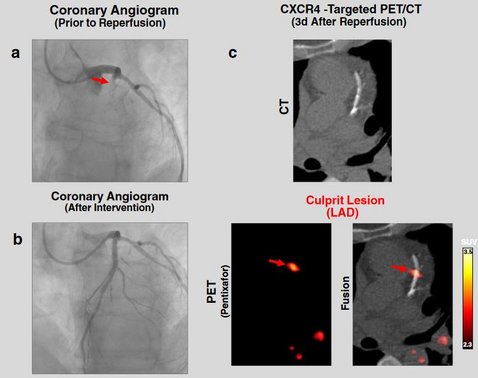
03.07.2018
PURPOSE: The chemokine receptor CXCR4 is a promising target for molecular imaging of CXCR4+ cell types, e.g. inflammatory cells, in cardiovascular diseases. We speculated that a specific CXCR4 ligand, [68Ga]pentixafor, along with novel techniques for motion correction, would facilitate the in vivo characterization of CXCR4 expression in small culprit and nonculprit coronary atherosclerotic lesions after acute myocardial infarction by motion-corrected targeted PET/CT. METHODS: CXCR4 expression was analysed ex vivo in separately obtained arterial wall specimens. [68Ga]Pentixafor PET/CT was performed in 37 patients…
Anti-Inflammatory Effects on Atherosclerotic Lesions Induced by CXCR4-Directed Endoradiotherapy
03.07.2018
[68Ga]Ga-Pentixafor PET/MRI for CXCR4 Imaging of Chronic Lymphocytic Leukemia: Preliminary Results
01.07.2018
OBJECTIVES: This prospective proof-of-principle study aimed to determine whether [Ga]Ga-Pentixafor uptake, which reflects CXCR4 expression, is higher in the bone marrow of chronic lymphocytic leukemia (CLL) than in other oncological diseases without bone marrow infiltration and can therefore be used for CLL imaging. MATERIALS AND METHODS: Thirteen CLL patients and 20 controls (10 with pancreatic adenocarcinoma and 10 with mucosa-associated lymphoid tissue lymphoma) with histologically proven cancer…
Equilibrium Thermodynamics, Formation, and Dissociation Kinetics of Trivalent Iron and Gallium Complexes of Triazacyclononane-Triphosphinate (TRAP) Chelators: Unraveling the Foundations of Highly Selective Ga-68 Labeling

23.05.2018
In order to rationalize the influence of FeIII contamination on labeling with the 68Ga eluted from 68Ge/68Ga-generator, a detailed investigation was carried out on the equilibrium properties, formation and dissociation kinetics of GaIII- and FeIII-complexes of 1,4,7-triazacyclononane-1,4,7-tris(methylene[2-carboxyethylphosphinic acid]) (H6TRAP). The stability and protonation constants of the [Fe(TRAP)]3- complex were determined…
Feasibility of CXCR4-directed radioligand therapy in advanced diffuse large B cell lymphoma
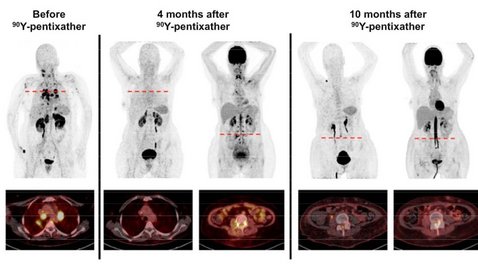
18.05.2018
We have recently reported on our experience with C-X-C-motif chemokine receptor 4- (CXCR4-) directed radioligand therapy (RLT) in multiple myeloma and acute leukemia. Methods: Six patients with heavily pre-treated relapsed diffuse large B cell lymphoma (DLBCL) (3 males, 3 females; aged, 54±8 years) underwent CXCR4-directed RLT in combination with conditioning chemotherapy and allogeneic stem cell transplantation…
Modeling and predicting tumor response in radioligand therapy
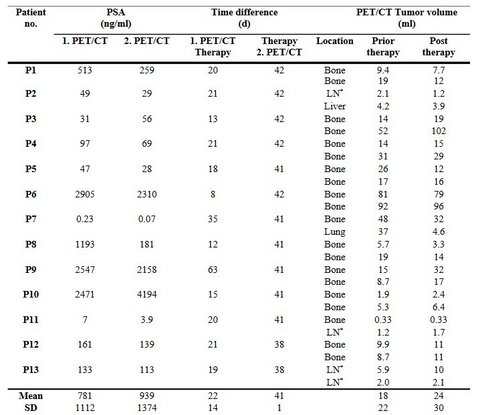
10.05.2018
The aim of this work was to develop a theranostic method that allows predicting PSMA-positive tumor volume after radioligand therapy (RLT) based on a pre-therapeutic PET/CT measurement and physiologically based pharmacokinetic/dynamic (PBPK/PD) modeling at the example of RLT using 177Lu-labeled PSMA for imaging and therapy (PSMA I&T). Methods: A recently developed PBPK model for 177Lu PSMA I&T RLT was extended…
From a Helix to a Small Cycle: Metadynamics-Inspired αvβ6 Integrin Selective Ligands
16.04.2018
The RGD-recognizing αvβ6 integrin has only recently emerged as a major target for cancer diagnosis and therapy. Thus, the development of selective, low-molecular-weight ligands of this receptor is still in great demand. Here, a metadynamics-driven design strategy allowed us…
Synthesis and preclinical evaluation of novel 18F-labeled Glu-urea-Glu-based PSMA inhibitors for prostate cancer imaging: a comparison with 18F-DCFPyl and 18F-PSMA-1007
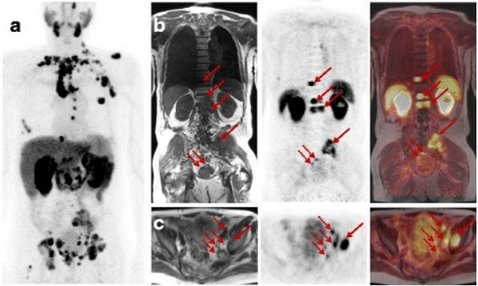
12.04.2018
BACKGROUND: Due to its high and consistent expression in prostate cancer (PCa), the prostate-specific membrane antigen (PSMA) represents an ideal target for molecular imaging and targeted therapy using highly specific radiolabeled PSMA ligands. To address the continuously growing clinical demand for 18F-labeled PSMA-probes, we developed two novel Glu-urea-Glu-(EuE)-based inhibitors, EuE-k-18F-FBOA (1) and EuE-k-β-a-18F-FPyl (2), both with optimized linker structure and different 18F-labeled aromatic moieties. The inhibitors were evaluated in a comparative preclinical study with 18F-DCFPyl and 18F-PSMA-1007. RESULTS: Radiolabeling procedures allowed preparation of (1) and (2) with high radiochemical yields…
Synthesis of Symmetrical Tetrameric Conjugates of the Radiolanthanide Chelator DOTPI for Application in Endoradiotherapy by Means of Click Chemistry
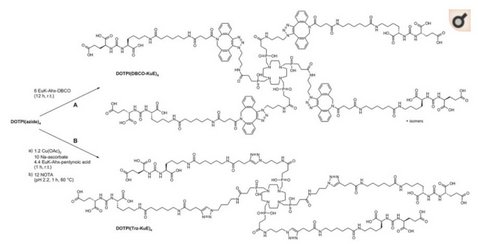
10.04.2018
Due to its 4 carbonic acid groups being available for bioconjugation, the cyclen tetraphosphinate chelator DOTPI, 1,4,7,10-tetraazacyclododecane-1,4,7, 10-tetrakis[methylene(2-carboxyethylphosphinic acid)], represents an ideal scaffold for synthesis of tetrameric bioconjugates for labeling with radiolanthanides, to be applied as endoradiotherapeuticals. We optimized a protocol for bio-orthogonal DOTPI…
Isolated metastasis of an EGFR-L858R-mutated NSCLC of the meninges: the potential impact of CXCL12/CXCR4 axis in EGFRmut NSCLC in diagnosis, follow-up and treatment
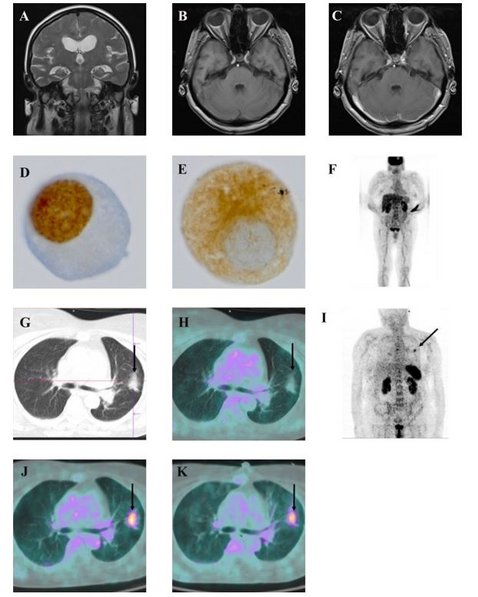
10.04.2018
Brain and leptomeningeal metastasis (LMM) of non-small cell lung cancer is still associated with poor prognosis. Moreover, the current diagnostic standard for LMM often yields false negative results and the scientific progress in this field is still unsatisfying. We present a case of a 71-year old patient with an isolated LMM. While standard diagnostics could only diagnose a cancer of unknown primary, the use…
In vivo characterization of four 68Ga-labeled multimeric RGD peptides to image αvβ3 integrin expression in two human tumor xenograft mouse models
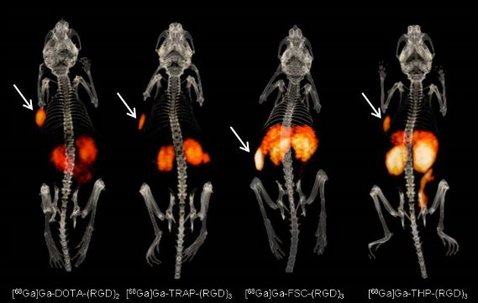
06.04.2018
Rationale: αvβ3 integrins play an important role in angiogenesis and cell migration of cancers. They are highly expressed on activated endothelial cells of newly formed blood vessels. Here, we compare the targeting characteristics of four 68Ga-labeled multimeric cyclic arginine-glycine-aspartate RGD-based tracers in an αvβ3 integrin-expressing tumor model and in a tumor model where αvβ3 integrin is expressed solely on the neovasculature. Methods: Female BALB/c nude mice were subcutaneously injected with SK-RC-52 (αvβ3 integrin-positive) or FaDu (αvβ3 integrin-negative) tumor…
99mTechnetium-based Prostate-specific Membrane Antigen-radioguided Surgery in Recurrent Prostate Cancer
03.04.2018
BACKGROUND: Prostate-specific membrane antigen (PSMA)-targeted positron emission tomography (PET) can visualize metastatic lesions in recurrent prostate cancer (PC). However, reliable identification of small and/or atypically localized lesions during salvage surgery procedures is challenging. OBJECTIVE:To describe the technique, feasibility, and short-term outcomes of 99mTechnetium (99mTc)-based PSMA-radioguided surgery (99mTc-PSMA-RGS) for removal of recurrent PC lesions. DESIGN, SETTING, AND PARTICIPANTS: Thirty-one consecutive patients…
[68Ga]Pentixafor-PET/MRI for the detection of Chemokine receptor 4 expression in atherosclerotic plaques
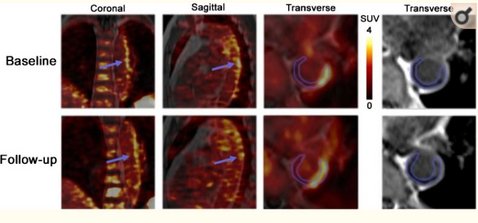
01.04.2018
PURPOSE: The expression of chemokine receptor type 4 (CXCR4) was found co-localized with macrophages on the atherosclerotic vessel wall and participated in the initial emigration of leukocytes. Gallium-68 [68Ga]Pentixafor has recently been introduced for the imaging of atherosclerosis by targeting CXCR4. We sought to evaluate human atherosclerotic lesions using [68Ga]Pentixafor PET/MRI. METHODS: Thirty-eight oncology patients underwent [68Ga]Pentixafor PET/MR imaging at baseline. Maximum standardized uptake values…
Patterns of relapse as determined by 68Ga-PSMA ligand PET/CT after radical prostatectomy : Importance for tailoring and individualizing treatment
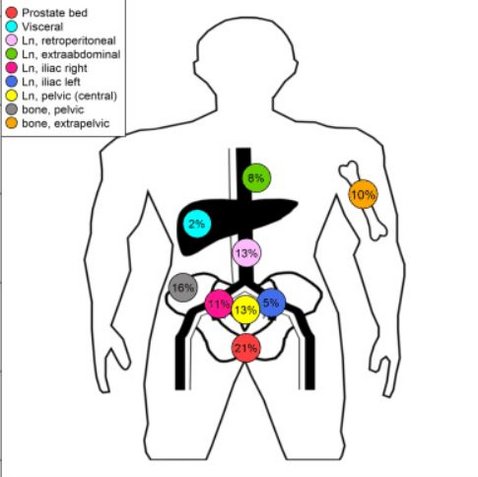
01.04.2018
PURPOSE: To evaluate the patterns of relapse and impact on the intended treatment when using 68Ga-prostate-specific membrane antigen (PSMA) ligand positron emission tomography/computed tomography (PET/CT) imaging for restaging of disease in patients with biochemical relapse after radical prostatectomy (RP) before salvage radiotherapy (sRT). METHODS: In all, 39 patients with biochemical recurrence after RP who had no primary indication for adjuvant RT due to the absence of biologically unfavorable…
N-Methylation of isoDGR Peptides: Discovery of a Selective α5β1-Integrin Ligand as a Potent Tumor Imaging Agent
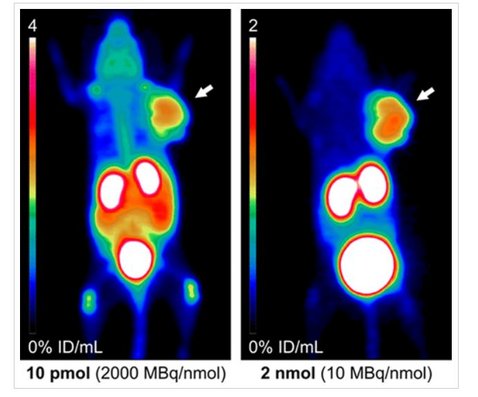
22.03.2018
Specific targeting of the integrin subtype α5β1 possesses high potential in cancer diagnosis and therapy. Through sequential N-methylation, we successfully converted the biselective α5β1/αvβ6 peptide c(phg- isoDGR-k) into a potent peptidic RGD binding α5β1 subtype selective ligand c(phg- isoDGR-( NMe)k). Nuclear magnetic resonance spectroscopy...
Molecular Imaging in Oncology Using Positron Emission Tomography
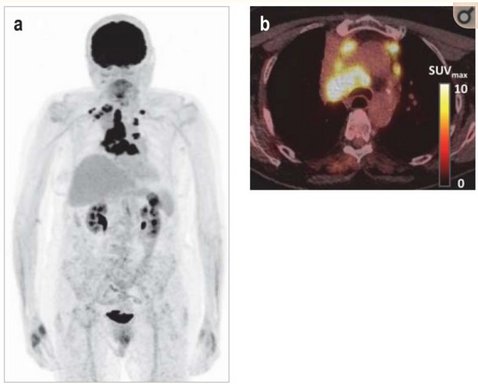
16.03.2018
BACKGROUND: Anatomical and molecular data can be acquired simultaneously through the use of positron emission tomography (PET) in combination with computed tomography (CT) or magnetic resonance imaging (MRI) as a hybrid technique. A variety of radiopharmaceuticals can be used to characterize various metabolic processes or to visualize the expression of receptors, enzymes…
Seeing the unseen: post-infarction inflammation in an isolated right ventricular myocardial infarction visualized by combined cardiac magnetic resonance imaging and chemokine receptor CXCR4-targeted molecular imaging
14.03.2018
CXCR4 Is a Potential Target for Diagnostic PET/CT Imaging in Barrett's Dysplasia and Esophageal Adenocarcinoma
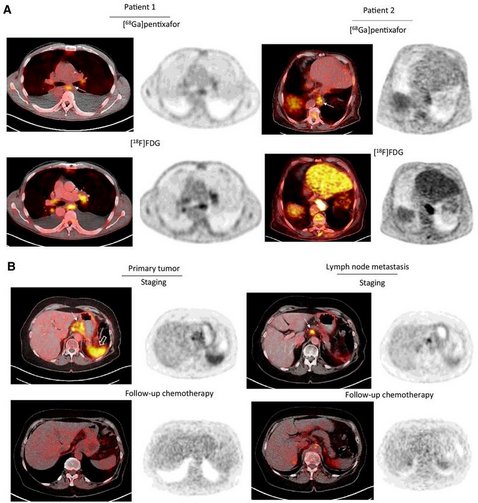
01.03.2018
Purpose: Barrett's esophagus represents an early stage in carcinogenesis leading to esophageal adenocarcinoma. Considerable evidence supports a major role for chronic inflammation and diverse chemokine pathways in the development of Barrett's esophagus and esophageal adenocarcinoma.Experimental Design: Here we utilized an IL1β transgenic mouse model of Barrett's esophagus and esophageal adenocarcinoma and human patient imaging…
Re-thinking the role of radiometal isotopes: Towards a future concept for theranostic radiopharmaceuticals
01.03.2018
The potential and future role of certain metal radionuclides, for example, 44 Sc, 89 Zr, 86 Y, 64 Cu, 68 Ga, 177 Lu, 225 Ac, and 213 Bi, and several terbium isotopes has been controversially discussed in the past decades. Furthermore, the possible benefits of "matched pairs" of isotopes for tandem applications of diagnostics and therapeutics (theranostics) have been emphasized, while such approaches still have not made their way into routine…
Therapeutic Radiopharmaceuticals Targeting Integrin αvβ6

28.02.2018
The epithelial integrin αvβ6 is expressed by many malignant carcinoma cell types, including pancreatic cancer, and thus represents a promising target for radionuclide therapy. The peptide cyclo(FRGDLAFp(NMe)K) was decorated with different chelators (DOTPI, DOTAGA, and DOTA). The Lu(III) complexes of these conjugates exhibited comparable αvβ6 integrin affinities…
Imaging of C-X-C Motif Chemokine Receptor CXCR4 Expression After Myocardial Infarction With [68Ga]Pentixafor-PET/CT in Correlation With Cardiac MRI
09.02.2018
Targeting CXCR4 (CXC Chemokine Receptor Type 4) for Molecular Imaging of Aldosterone-Producing Adenoma
01.02.2018
Primary aldosteronism is the most frequent cause of secondary hypertension and is associated with increased morbidity and mortality compared with hypertensive controls. The central diagnostic challenge is the differentiation between bilateral and unilateral disease, which determines treatment options. Bilateral adrenal venous sampling, currently recommended for differential diagnosis, is an invasive procedure…
Clinical Molecular Imaging of Chemokine Receptor CXCR4 Expression in Atherosclerotic Plaque Using 68Ga-Pentixafor PET: Correlation with Cardiovascular Risk Factors and Calcified Plaque Burden
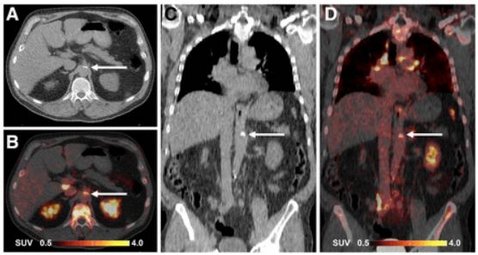
01.02.2018
The CXC-motif chemokine receptor 4 (CXCR4) represents a promising target for molecular imaging of different CXCR4-positive cell types in cardiovascular diseases such as atherosclerosis and arterial wall injury. The aim of this study was to assess…
68Ga-Pentixafor PET/CT Imaging of Chemokine Receptor CXCR4 in Chronic Infection of the Bone: First Insights

01.02.2018
Because of its role in infection and inflammatory processes, the chemokine receptor CXCR4 might be a potent target in imaging of infectious and inflammatory diseases. The aim of this pilot study was to determine whether the CXCR4 ligand 68Ga-pentixafor is suitable for imaging chronic infection of the bone. Methods: The study comprised 14 patients with suspected infection of the skeleton who underwent 68Ga-pentixafor PET/CT…
Potential influence of concomitant chemotherapy on CXCR4 expression in receptor directed endoradiotherapy
24.01.2018
Dual-Nuclide Radiopharmaceuticals for Positron Emission Tomography Based Dosimetry in Radiotherapy
12.01.2018
Improvement of the accuracy of dosimetry in radionuclide therapy has the potential to increase patient safety and therapeutic outcomes. Although positron emission tomography (PET) is ideally suited for acquisition of dosimetric data because PET is inherently quantitative and offers high sensitivity and spatial resolution, it is not directly applicable…
From interventionist imaging to intraoperative guidance: New perspectives by combining advanced tools and navigation with radio-guided surgery
01.01.2018
The integration of medical imaging technologies into diagnostic and therapeutic approaches can provide a preoperative insight into both anatomical (e.g. using computed tomography, magnetic resonance imaging, or ultrasound), as well as functional aspects (e.g. using single photon emission computed tomography, positron emission tomography, lymphoscintigraphy…
Dual Targeting of Acute Leukemia and Supporting Niche by CXCR4-Directed Theranostics
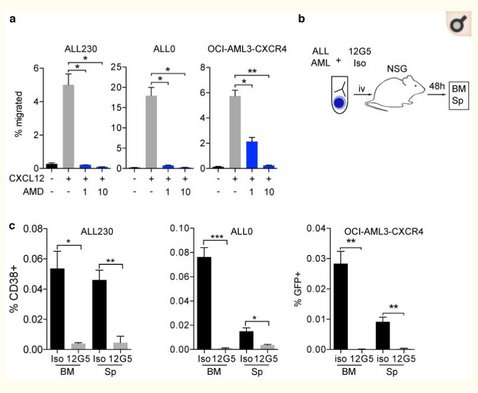
01.01.2018
C-X-C chemokine receptor 4 (CXCR4) is a transmembrane receptor with pivotal roles in cell homing and hematopoiesis. CXCR4 is also involved in survival, proliferation and dissemination of cancer, including acute lymphoblastic and myeloid leukemia (ALL, AML). Relapsed/refractory ALL and AML are frequently resistant to conventional therapy…